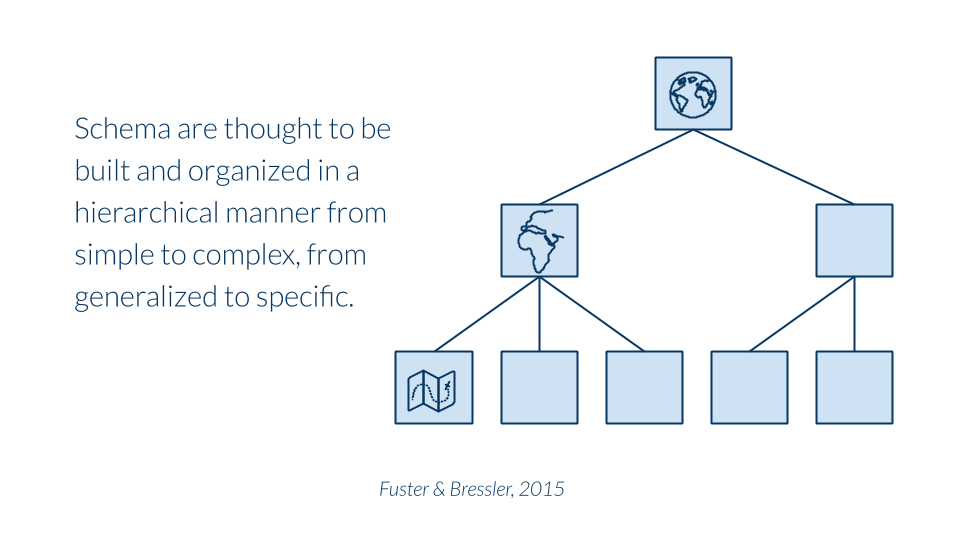*An introduction to some Science of Learning Theories on Building & Applying Knowledge
Our Knowledge System
Our knowledge system consists of schema (i.e. mental models), networks of related information, that is stored in our long-term memory (LTM). LTM holds schema that vary in degree of complexity and automation (Van Merrienboer & Sweller, 2010). One way to relate to schema is to think about maps and navigation. For example, where are we right now? We can say “Spain” within the context of the world and mentally pull up a map or schema of the world. We could also say Barcelona, but that world map would lack detail. So perhaps Barcelona within a schema of southern Europe or Spain itself. We could say the room number we’re in. The previous schema wouldn’t be appropriate. We’d need a schema for this floor or building. However, we can easily move ourselves from one of these “maps” to the other with little effort. These schemata have largely been automated in us but hold vast amounts of information that we can use to apply to the problem at hand – answering where we are and where we need to navigate to.
Over the past ten years or so, the neural mechanisms underlying schema have become clearer (e.g. such as how schema are represented, activated, and updated in the brain). It is believed that schema are built and organized in a hierarchical manner from simple to complex, from generalized to specific. “Information available at lower levels of the hierarchy, states of sensory systems, for example, is hierarchically recoded into representations of increasing generality, which are then used to interpret the incoming lower-order data” (Kukushkin & Carew, 2017).

This hierarchical organization is physically represented by how the schema are constructed in the brain. The text below provides an example of the hierarchical organization of schema in the brain. Note that the purpose of the text that follows is to illustrate how theories on schema align with the functional and structural properties of the brain – and do not solely rely on behavioural studies. To learn more about brain anatomy, recommended resources include:
- A simple overview from the Mayfield Clinic (http://www.mayfieldclinic.com/pe-anatbrain.htm);
- A video lesson on neuroanatomy from UBC Medicine (https://www.youtube.com/watch?v=xB7rXw_3gVY).
The cortex which is the outer layer of the brain plays a role in higher level functions such as attention, perception, awareness, thought, memory, language, and consciousness. Schema are thought to be constructed in the brain from the upper to lower cortex. Fuster & Bressler (2015) provide a representation of the general to detailed structure of our cortex in their paper, Past makes future: role of pFC in prediction. In the upper cortex would be the concept of a “bird.” As we get lower in the cortex, we get more specific associations for types of birds such as a “canary”. And in the sensory cortex we find the specific qualities such as colours, sounds, and smells. Thus, the general to specific hierarchical levels are mirrored physically when represented in the brain. “Memories as well as items of knowledge consist of distributed and hierarchically organized cortical networks” (Fuster, 2009).
Associations
Schema are connected via associations – commonalities vs. differences. This is also reflected in the two types of signals in our brain – excitatory and inhibitory. Excitatory signals strengthen items that are related (commonalities). Inhibitory signals weaken items that are not related (differences) (Fuster & Bressler, 2015).
References
Our Knowledge System
- Van Merriënboer, J. J., & Sweller, J. (2010). Cognitive load theory in health professional education: design principles and strategies. Medical education, 44(1), 85-93.
- Fuster, J. M. (2009). Cortex and memory: emergence of a new paradigm. Journal of cognitive neuroscience, 21(11), 2047-2072.
- Fuster, J. M., & Bressler, S. L. (2015). Past makes future: role of pFC in prediction. Journal of cognitive neuroscience, 27(4), 639-654.
- Kukushkin, N. V., & Carew, T. J. (2017). Memory Takes Time. Neuron, 95(2), 259-279.
- Gilboa, A., & Marlatte, H. (2017). Neurobiology of schemas and schema-mediated memory. Trends in cognitive sciences, 21(8), 618-631.
- van Kesteren, M. T., Ruiter, D. J., Fernández, G., & Henson, R. N. (2012). How schema and novelty augment memory formation. Trends in neurosciences, 35(4), 211-219.
- Squire, L. R., Genzel, L., Wixted, J. T., & Morris, R. G. (2015). Memory consolidation. Cold Spring Harbor perspectives in biology, 7(8), a021766.
Associations
- Fuster, J. M., & Bressler, S. L. (2015). Past makes future: role of pFC in prediction. Journal of cognitive neuroscience, 27(4), 639-654.
